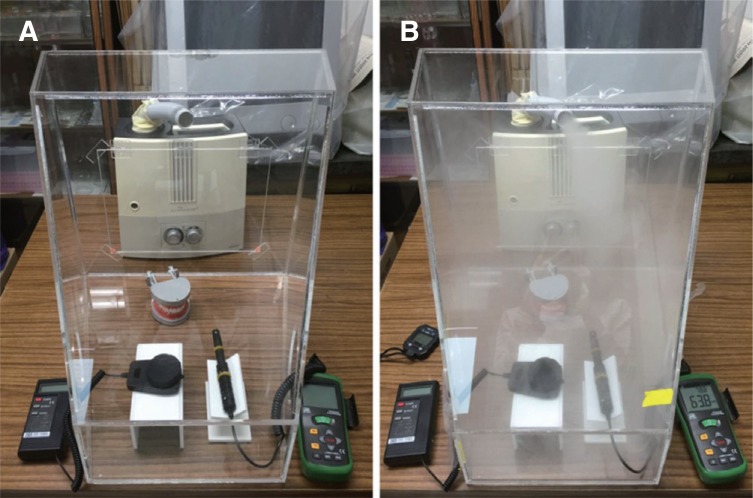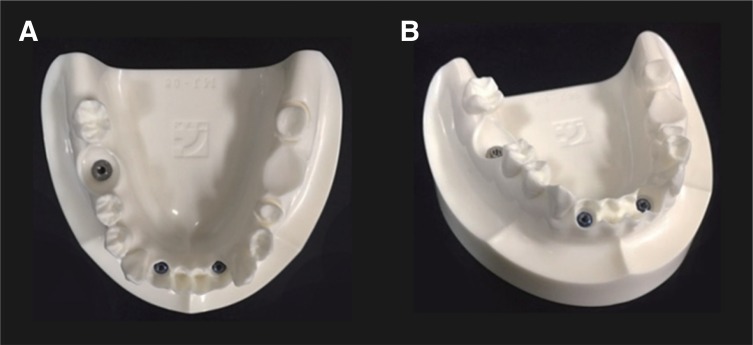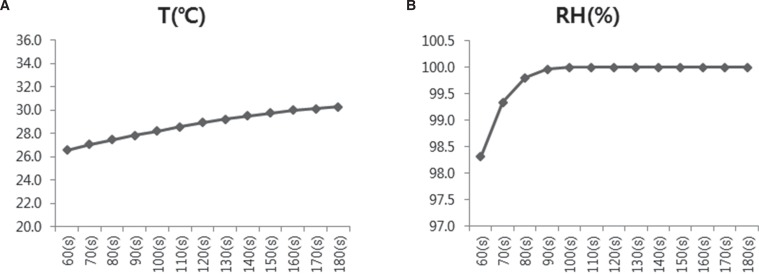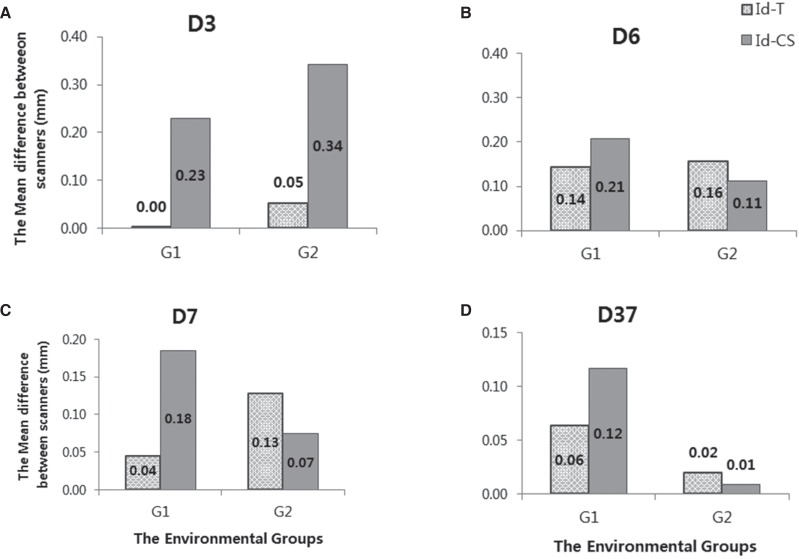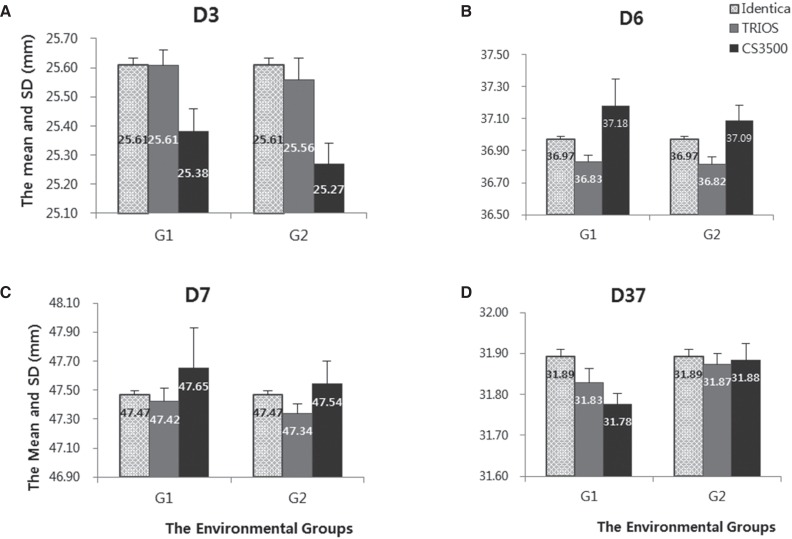J Adv Prosthodont.
2018 Feb;10(1):58-64. 10.4047/jap.2018.10.1.58.
A comparison of the accuracy of intraoral scanners using an intraoral environment simulator
- Affiliations
-
- 1Department of Oral Anatomy, School of Dentistry, Seoul National University, Seoul, Republic of Korea. orana9@snu.ac.kr
- 2Department of Prosthodontics and Dental Research Institute, School of Dentistry, Seoul National University, Seoul, Republic of Korea.
- 3Department of Oral Maxillofacial Radiology, School of Dentistry, Seoul National University, Seoul, Republic of Korea.
- KMID: 2403999
- DOI: http://doi.org/10.4047/jap.2018.10.1.58
Abstract
- PURPOSE
The aim of this study was to design an intraoral environment simulator and to assess the accuracy of two intraoral scanners using the simulator.
MATERIALS AND METHODS
A box-shaped intraoral environment simulator was designed to simulate two specific intraoral environments. The cast was scanned 10 times by Identica Blue (MEDIT, Seoul, South Korea), TRIOS (3Shape, Copenhagen, Denmark), and CS3500 (Carestream Dental, Georgia, USA) scanners in the two simulated groups. The distances between the left and right canines (D3), first molars (D6), second molars (D7), and the left canine and left second molar (D37) were measured. The distance data were analyzed by the Kruskal-Wallis test.
RESULTS
The differences in intraoral environments were not statistically significant (P>.05). Between intraoral scanners, statistically significant differences (P < .05) were revealed by the Kruskal-Wallis test with regard to D3 and D6.
CONCLUSION
No difference due to the intraoral environment was revealed. The simulator will contribute to the higher accuracy of intraoral scanners in the future.
Figure
Cited by 1 articles
-
Digital evaluation of axial displacement by implant-abutment connection type: An in vitro study
Sung-Jun Kim, KeunBaDa Son, Kyu-Bok Lee
J Adv Prosthodont. 2018;10(5):388-394. doi: 10.4047/jap.2018.10.5.388.
Reference
-
1. Duret F, Blouin JL, Duret B. CAD-CAM in dentistry. J Am Dent Assoc. 1988; 117:715–720. PMID: 3058771.
Article2. Logozzo S, Zanetti EM, Franceschini G, Kilpelä A, Mäkynen A. Recent advances in dental optics - Part I: 3D intraoral scanners for restorative dentistry. Opt Lasers Eng. 2014; 54:203–221.
Article3. Morris JB. CAD/CAM options in dental implant treatment planning. J Calif Dent Assoc. 2010; 38:333–336. PMID: 20572527.4. Kachalia PR, Geissberger MJ. Dentistry a la carte: in-office CAD/CAM technology. J Calif Dent Assoc. 2010; 38:323–330. PMID: 20572526.5. Andriessen FS, Rijkens DR, van der Meer WJ, Wismeijer DW. Applicability and accuracy of an intraoral scanner for scanning multiple implants in edentulous mandibles: a pilot study. J Prosthet Dent. 2014; 111:186–194. PMID: 24210732.
Article6. Flügge TV, Schlager S, Nelson K, Nahles S, Metzger MC. Precision of intraoral digital dental impressions with iTero and extraoral digitization with the iTero and a model scanner. Am J Orthod Dentofacial Orthop. 2013; 144:471–478. PMID: 23992820.
Article7. Patzelt SB, Emmanouilidi A, Stampf S, Strub JR, Att W. Accuracy of full-arch scans using intraoral scanners. Clin Oral Investig. 2014; 18:1687–1694.
Article8. TRIOS. 3Shape. 2016. Available from: http://dentalaxess.com/blog/work/3shape-trios/.9. Carestream Dental. 2016. Available from: http://www.carestreamdental.com/ImagesFileShare/.sitecore.media_library.Files.Intraoral_Scanner.CS_3500.PROOF12318CS3500BrochureUS85x11.pdf.10. Hack G, Patzelt S. Evaluation of the accuracy of six intraoral scanning devices: An in-vitro investigation. ADA Prof Prod Rev. 2015; 10:1–5.11. Flügge TV, Att W, Metzger MC, Nelson K. Precision of dental implant digitization using intraoral scanners. Int J Prosthodont. 2016; 29:277–283. PMID: 27148990.
Article12. Patzelt SB, Bishti S, Stampf S, Att W. Accuracy of computeraided design/computer-aided manufacturing-generated dental casts based on intraoral scanner data. J Am Dent Assoc. 2014; 145:1133–1140. PMID: 25359645.
Article13. Yoshida Y. The effect of environmental temperature and humidity on the adhesion of composite resins to the etched enamel surface. Jpn J Conserv Dent. 1983; 26:412–426.14. Spierings TA, Peters MC, Plasschaert AJ. Surface temperature of oral tissues. A review. J Biol Buccale. 1984; 12:91–99. PMID: 6381478.15. Creed B, Kau CH, English JD, Xia JJ, Lee RP. A comparison of the accuracy of linear measurements obtained from cone beam computerized tomography images and digital models. Semin Orthod. 2011; 17:49–56. PMID: 26568670.
Article16. Saraiva LO, Aguiar TR, Costa L, Cavalcanti AN, Giannini M, Mathias P. Influence of intraoral temperature and relative humidity on the dentin bond strength: an in situ study. J Esthet Restor Dent. 2015; 27:92–99. PMID: 24629068.
Article17. Besnault C, Attal JP. Influence of a simulated oral environment on dentin bond strength of two adhesive systems. Am J Dent. 2001; 14:367–372. PMID: 11949796.18. Ender A, Mehl A. Accuracy of complete-arch dental impressions: a new method of measuring trueness and precision. J Prosthet Dent. 2013; 109:121–128. PMID: 23395338.19. Hayashi K, Sachdeva AU, Saitoh S, Lee SP, Kubota T, Mizoguchi I. Assessment of the accuracy and reliability of new 3-dimensional scanning devices. Am J Orthod Dentofacial Orthop. 2013; 144:619–625. PMID: 24075671.
Article20. Nedelcu RG, Persson AS. Scanning accuracy and precision in 4 intraoral scanners: an in vitro comparison based on 3-dimensional analysis. J Prosthet Dent. 2014; 112:1461–1471. PMID: 25134995.21. Identica hybrid. 2016. Available from: http://dentaldigital.gr/wp-content/uploads/2016/01/IdenticaHybrid_Manual.pdf.22. Jeong ID, Lee JJ, Jeon JH, Kim JH, Kim HY, Kim WC. Accuracy of complete-arch model using an intraoral video scanner: An in vitro study. J Prosthet Dent. 2016; 115:755–759. PMID: 26794703.
- Full Text Links
- Actions
-
Cited
- CITED
-
- Close
- Share
- Similar articles
-
- Full-arch accuracy of five intraoral scanners:In vivo analysis of trueness and precision
- A novel method for testing accuracy of bite registration using intraoral scanners
- Comparison of the accuracy of intraoral scanner by three-dimensional analysis in single and 3-unit bridge abutment model: In vitro study
- Effect of the volumetric dimensions of a complete arch on the accuracy of scanners
- Effect of scanning strategies on the accuracy of digital intraoral scanners: a meta-analysis of in vitro studies


